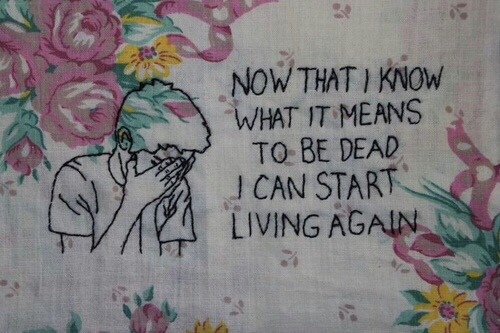#endthestigma
Text
🧡🧡🧡🧡🧡🧡🧡🇨🇦🇨🇦🇨🇦🇨🇦🇨🇦✊✊✊✊✊✊✊END THE STIGMA!!!!!
174 notes
·
View notes
Text

121 notes
·
View notes
Text

#depression#mentalhealth#anxiety#sadness#hopelessness#isolation#loneliness#fatigue#loss#grief#mentalhealthawareness#mentalhealthsupport#endthestigma#youarenotalone
28 notes
·
View notes
Text
Explorando el Trastorno Límite de la Personalidad: Una Reflexión Profunda

¿Alguna vez has sentido que tus emociones son como montañas rusas, subiendo y bajando sin control aparente?
¿Te has visto envuelto en relaciones turbulentas que parecen desmoronarse tan rápido como comenzaron? Si te sientes identificado con estas experiencias, podrías estar enfrentando lo que se conoce como Trastorno Límite de la Personalidad (TLP), aunque es posible que no lo sepas. Aunque puede ser un desafío, hay mucha ayuda disponible. Vamos a sumergirnos un poco en este mundo para entenderlo mejor.
¿Qué es el TLP?
El Trastorno Límite de la Personalidad (TLP), también conocido como trastorno borderline, es una condición mental compleja que afecta la manera en que una persona piensa, se siente y se relaciona con los demás. Se caracteriza por patrones de emociones turbulentas o inestables, impulsividad y relaciones interpersonales problemáticas. Las personas con TLP a menudo experimentan un intenso temor al abandono, tienen una autoimagen inestable y pueden alternar entre idealizar y desvalorizar a las personas en sus vidas. Este trastorno puede causar un gran sufrimiento y dificultades en diversos aspectos de la vida de quienes lo experimentan, incluyendo relaciones personales, trabajo, y autoimagen.
¿Qué causa este trastorno?
La causa exacta del Trastorno Límite de la Personalidad (TLP) es aún objeto de debate entre los expertos en salud mental. Se reconoce que el TLP es una condición multifactorial, lo que significa que resulta de una combinación de diferentes factores biológicos, genéticos, ambientales y psicosociales.
Se ha observado que existen ciertos factores de riesgo que pueden aumentar la probabilidad de desarrollar TLP, como antecedentes familiares de trastornos mentales, experiencias traumáticas en la infancia (como abuso físico, sexual o emocional), inestabilidad en el entorno familiar, predisposición genética y factores ambientales estresantes.
Es importante destacar que no existe una única causa que explique el desarrollo del TLP en todas las personas. Más bien, es la interacción compleja de estos diversos factores lo que contribuye al desarrollo de la condición.

Identificando el TLP: Señales y Síntomas
Identificar el Trastorno Límite de la Personalidad (TLP) puede ser desafiante debido a la variedad de formas en que se manifiesta en las personas. Sin embargo, hay una serie de señales y síntomas comunes que pueden indicar la presencia de este trastorno:
Miedo al abandono: Las personas con TLP a menudo experimentan un miedo intenso al abandono, lo que puede llevarlas a realizar esfuerzos desesperados para evitar que otros se vayan, incluso cuando el riesgo de abandono es mínimo.
Inestabilidad emocional: Las emociones de las personas con TLP pueden ser intensas, cambiantes y difíciles de controlar. Pueden pasar de sentirse eufóricas a deprimidas en cuestión de minutos u horas.
Inestabilidad en las relaciones: Las relaciones interpersonales de las personas con TLP suelen ser tumultuosas y caóticas. Pueden alternar entre idealizar a alguien y desvalorizarlo rápidamente, lo que dificulta mantener relaciones estables y saludables.
Comportamiento impulsivo: La impulsividad es común en las personas con TLP, lo que puede manifestarse en comportamientos como el gasto impulsivo, las conductas sexuales de riesgo, el abuso de sustancias, los cambios repentinos en los planes de vida y la alimentación compulsiva.
Autolesiones o comportamientos suicidas: Las personas con TLP pueden recurrir a la autolesión, como cortarse o quemarse, como una forma de aliviar el dolor emocional intenso. Además, tienen un mayor riesgo de realizar intentos de suicidio.
Inestabilidad en la autoimagen: Las personas con TLP pueden tener una percepción de sí mismas que cambia rápidamente, lo que puede dificultar la formación de una identidad coherente y estable.
Ira inapropiada o dificultad para controlar la ira: Las personas con TLP pueden experimentar ráfagas intensas de ira que son desproporcionadas a la situación o tener dificultades para controlar su ira, lo que puede resultar en conflictos interpersonales.
Estas son algunas de las señales y síntomas más comunes del Trastorno Límite de la Personalidad, pero es importante recordar que cada persona puede experimentar el TLP de manera única y que el diagnóstico debe ser realizado por un profesional de la salud mental.
Diagnóstico y Tratamiento: Caminos hacia la Recuperación
Si sientes que estás luchando contra una montaña rusa emocional sin freno de emergencia, es hora de buscar ayuda. El diagnóstico del TLP implica abrirse a conversaciones profundas con profesionales de la salud mental que te guiarán en este viaje. El tratamiento a menudo combina terapias que te ayudarán a entender y manejar tus emociones, junto con posibles medicamentos que pueden aliviar los síntomas más difíciles.
“Diagnóstico y Tratamiento: Caminos hacia la Recuperación” destaca la importancia fundamental de la evaluación adecuada y la atención terapéutica en el manejo del Trastorno Límite de la Personalidad (TLP). Esta frase reconoce que el diagnóstico preciso y el tratamiento efectivo son pasos cruciales en el viaje hacia la recuperación.
Al enfatizar los “Caminos hacia la Recuperación”, la frase sugiere que no existe una sola solución para todos. Cada individuo puede encontrar su propio camino hacia la recuperación, con el apoyo adecuado y una atención personalizada. Esto puede incluir terapias psicoterapéuticas como la terapia cognitivo-conductual, la terapia dialéctica conductual y la terapia de esquemas, así como la posible incorporación de medicación cuando sea estrictamente necesario.
En resumen, “Diagnóstico y Tratamiento: Caminos hacia la Recuperación” subraya la importancia de un enfoque holístico y personalizado en el abordaje del TLP, reconociendo que la recuperación es un viaje único para cada individuo y que hay múltiples senderos que pueden llevar hacia la estabilizacion y la sanación. Si te identificas con estos síntomas, no dudes en buscar ayuda. Hay recursos disponibles y profesionales de la salud mental capacitados, para ayudarte solventar tu problema y guiarte por el camino correcto. ¡Recuerda hay alternativas ,no tires la toalla !

La Esperanza Vive: Superando el Estigma del Trastorno Límite de la Personalidad
El Trastorno Límite de la Personalidad (TLP) es una condición que no discrimina por edad ni estatus. Desde jóvenes hasta adultos mayores, cualquiera puede encontrarse navegando estas aguas emocionales turbulentas. Figuras conocidas como Britney Spears y Angelina Jolie han compartido sus propias batallas con este trastorno, demostrando que no estás solo en este camino. Con el apoyo adecuado y el compromiso personal, es posible encontrar una vida plena y significativa más allá del TLP.
“La esperanza vive: Superando el estigma” es una afirmación poderosa que resuena profundamente en la lucha contra el Trastorno Límite de la Personalidad. Reconoce que, a pesar de los desafíos que enfrentan las personas que viven con este trastorno, existe una luz al final del túnel. Al abordar el estigma que rodea al TLP, se abre la puerta a la comprensión, la empatía y el apoyo mutuo.
Esta frase no solo destaca la importancia de mantener viva la esperanza, sino que también enfatiza la superación del estigma asociado con el trastorno. Al crear conciencia y promover la comprensión de la complejidad del TLP, estamos allanando el camino para que las personas afectadas encuentren el apoyo y la compasión que necesitan para prosperar.
En resumen, “La esperanza vive: Superando el estigma” es un recordatorio inspirador de que, a pesar de los obstáculos, cada individuo tiene el poder de superar el estigma y encontrar la esperanza en su camino hacia la recuperación y la plenitud. A través de la educación, la comprensión y el apoyo, podemos ayudar a aquellos que luchan con el TLP a encontrar la luz en la oscuridad y a vivir una vida plena y satisfactoria. ¡La esperanza vive en cada uno de nosotros!
Conclusión: Un Viaje de Autodescubrimiento
Encapsula la esencia de la experiencia de quienes enfrentan el Trastorno Límite de la Personalidad (TLP). Esta frase sugiere que más allá de los desafíos y tribulaciones, el camino hacia la recuperación es también un viaje de autodescubrimiento profundo y significativo.
En este viaje, las personas pueden encontrar una mayor comprensión de sí mismas, sus emociones y sus relaciones. A través del trabajo terapéutico y la autoexploración, descubren nuevas facetas de su ser y desarrollan habilidades para enfrentar los desafíos que presenta el TLP.
"Un Viaje de Autodescubrimiento" también transmite la idea de que la recuperación del TLP no es simplemente un proceso de curación externa, sino un camino hacia el autoconocimiento y la aceptación. Invita a quienes enfrentan el trastorno a embarcarse en este viaje con valentía y esperanza, sabiendo que el autodescubrimiento es parte integral de su camino hacia una vida más plena y satisfactoria.
El Trastorno Límite de la Personalidad es un desafío, pero no es el final del camino. Es una invitación a explorar nuestras emociones más profundas y descubrir herramientas para enfrentarlas. Si estás en este viaje, recuerda que no estás solo. Hay una comunidad de personas dispuestas a ayudarte a encontrar la luz al final del túnel y a vivir una vida plena, sin importar tu edad o tu historia.
Cortesía : @magneticovitalblog

#SaludMental#BienestarEmocional#TLPawareness#CuidadoMental#EndTheStigma#Empatía#Autodescubrimiento#SuperandoElTLP#ApoyoMutuo#VivirPlenamente#superacionpersonal
8 notes
·
View notes
Text


💚 Mental Health Matters Badges, for Mental Health Awareness week in May
#mentalhealthmatters#wellbeing#endthestigma#mentalhealthawareness#badges#ukhandmade#koolbadges#shopsmall#buttonbadges#bbloggers#25mm#badge#pins#craft#buttons#handmade#badgemaker#you got this#be kind to yourself#be kind to your mind#be kind to each other#be kind to others#be kind to yourselves#love yourself#mental health#end the stigma
8 notes
·
View notes
Text

5 Healthy Habits to Help Reduce Stress 🤗
Chronic stress raises heart disease and stroke risk, promoting unhealthy habits, but the American Heart Association emphasizes that reducing stress and fostering a positive mindset can enhance overall health.
The American Heart Association provides science-backed insights to help people reduce chronic stress and understand its impact on physical health.
Stay Active
Exercise is a simple path to physical and mental well-being, reducing disease risk, enhancing mental health, and boosting energy, with the American Heart Association suggesting at least 150 minutes of moderate or 75 minutes of vigorous activity per week.
Mediate
Meditation and mindfulness in your daily routine for brief stress relief, backed by studies showing benefits like lower blood pressure, enhanced sleep, stronger immune support, and improved cognitive abilities.
Practice Positivity
A positive mindset fosters better health, longevity, improved sleep, healthier habits, and reduced stress through positive self-talk and reframing challenges.
Show Gratitude
Practicing gratitude through daily reflection on three things you're thankful for can effectively reduce depression, anxiety, and enhance sleep.
Find a Furry Friend
Pet ownership, especially dogs, offers numerous health benefits, including improved fitness, reduced stress, lower health risks, and increased happiness, as supported by American Heart Association research.
#MentalHealth#MentalHealthMatters#EndTheStigma#Wellness#SelfCare#Mindfulness#Anxiety#Depression#MentalHealthAwareness#YouAreNotAlone#MentalHealthSupport#SelfLove#PositiveMentalHealth#Therapy#CopingStrategies
11 notes
·
View notes
Text
FROM TRAGEDY TO ART

Evelyn McHale's story is both tragic and hauntingly beautiful. On May 1, 1947, Evelyn, a 23-year-old woman from California, ended her life by jumping from the 86th-floor observation deck of the Empire State Building in New York City. She landed on a United Nations limousine parked at the curb below, a scene captured by photography student Robert Wiles just minutes after her death.
The photograph, titled "The Most Beautiful Suicide," depicts Evelyn lying peacefully amidst the crumpled metal of the car, her body seemingly untouched and almost angelic. The image has since become iconic, symbolizing both the tragedy of suicide and the eerie beauty of her final moments.
The photograph of Evelyn's death became famous not only for its tragic subject matter but also for its composition and the circumstances under which it was taken. Robert Wiles happened to be in the area when Evelyn jumped, and he quickly snapped the photo before police arrived. The image captures a moment of quiet and contemplation in the midst of chaos, adding to its haunting beauty.
I don't like the idea of calling Evelyn McHale's suicide a "beautiful suicide." It's not right to romanticize or glorify someone's tragic death. Suicide is a sad and serious thing, not something to be called beautiful. It's important to remember that behind every suicide is a person who was in deep pain and needed help. Calling it beautiful can make it seem like suicide is a good or noble thing, which it isn't. We should focus on helping people who are struggling instead of romanticizing their deaths.
I also don't like how people say the picture of Evelyn McHale's death is beautiful. It's a sad picture of a tragic moment. She lost her life, and that's not beautiful. It's important to have compassion and respect for her and her family, rather than focusing on the aesthetics of the image.
3 notes
·
View notes
Text
"But what else can I do? Nothing else to lose; you can scream in anger, I know it won't make it all better, But what else can I do?"
- Faouzia "100 Bandaids"
#Mental illness#Mental Health#MentalHealthAwareness#MentalHealthQuotes#BPD#Bipolar#ADHD#Obsessive Compulsive Disorder#Anxiety Disorder#Body Dysmorphic Disorder#PTSD Quotes#Childhood Trauma Therapy#Childhood Trauma#LifeQuotes#Recovery#Therapy#StayStrong#MusicQuotes#EndTheStigma#QuoteOfTheDay#SongLyrics#MentalHealthRecovery#YouAreNotAlone
2 notes
·
View notes
Text
Navigating the Mind
I recently had the chance to dive into the world of mental health and occupational therapy through the lens of the movie "A Beautiful Mind" (2001). It's incredible how a film can take you on an emotional rollercoaster and leave you with profound insights.
The movie tells the story of John Nash, a brilliant mathematician grappling with schizophrenia. His journey, filled with delusions and hallucinations, paints a vivid picture of the complexities of mental health conditions. It's safe to say that watching Nash's struggles and triumphs has forever changed the way I view this field.
Nash's life, dominated by his mental health condition, serves as a stark reminder of the occupational barriers individuals with mental health challenges face. As an occupational therapy (OT) student, I've come to understand the crucial role we play in breaking down these barriers. Our mission is to help people like Nash regain their independence and find meaning in their daily lives. "A Beautiful Mind" reinforced the idea that there's no one-size-fits-all approach – customized interventions are key.
In my own experiences working with clients battling mental health issues, I've seen firsthand how conditions like schizophrenia can lead to social isolation and make everyday tasks seem insurmountable. One client, much like Nash, struggled with auditory hallucinations that disrupted their ability to concentrate on basic activities. To help them, I had to adopt a holistic approach tailored to their unique needs.
The film simultaneously challenged and reinforced my understanding of mental health and occupational therapy. It reiterated that mental health conditions are intricate and can significantly impact a person's life. It underscored the importance of empathy and individualized care because everyone's journey is uniquely their own.
On the flip side, it pushed me to ponder the limitations of medical models in addressing mental health. Nash's recovery wasn't just about medication; it was about social support and his own resilience. This aligns with the holistic nature of occupational therapy, where we consider not only the physical but also the psychological and social aspects of well-being.
Throughout the movie, I couldn't help but wonder about the role OT could have played in Nash's life. We're trained to assess and address the impact of mental health conditions on daily activities. In Nash's case, an OT could have helped him develop coping strategies, manage symptoms, and adapt his environment to support his goals.
The film also shed light on the stigma surrounding mental illness. As OT students and future practitioners, we've seen how the lack of social support can worsen mental health issues. Part of our job is encouraging clients to connect with supportive friends, family, or support groups. It's a way to break down stigma and promote understanding, creating safe spaces for those battling mental health challenges.
Watching "A Beautiful Mind" has truly transformed my perspective as an OT student. It emphasized the importance of empathy, individualized care, and tackling occupational barriers in mental health rehabilitation. As I continue on my occupational therapy journey, I'm dedicated to advocating for the needs of individuals facing mental health challenges and helping them find meaning in their lives.

American Occupational Therapy Association's (AOTA) official website's mental health resources page - www.aota.org/mental-health-resources
A Beautiful Mind" a video where John Nash experiences a particularly challenging moment due to his schizophrenia https://youtu.be/ehhy-_Cg4QU?si=cK9QWvqM-pGacnxc
References:
1. American Occupational Therapy Association. (2014). What is occupational therapy? Retrieved from https://www.aota.org/About-Occupational-Therapy.aspx
2. American Occupational Therapy Association. (2021). Occupational therapy practice framework: Domain and process. American Journal of Occupational Therapy, 75(Supplement_2). https://doi.org/10.5014/ajot.2021.75S200
Goffman, E. (1963). Stigma: Notes on the management of spoiled identity. Prentice-Hall.
#MentalHealth#OccupationalTherapy#Schizophrenia#StigmaFree#MentalHealthAwareness#RecoveryJourney#OTStudent#Destigmatization#Wellness#Inclusion#Empathy#SupportSystem#Resilience#PersonalGrowth#OccupationalTherapist#MentalHealthRecovery#Healthcare#AwarenessMonth#EndTheStigma
4 notes
·
View notes
Text
Demystifying Dissociative Identity Disorder (DID)
Let's dive into a topic that often remains misunderstood and stigmatized: Dissociative Identity Disorder (DID). 💭💡
🧠 What is DID?
Dissociative Identity Disorder, formerly known as Multiple Personality Disorder, is a complex mental health condition where an individual's identity is fragmented into two or more distinct personality states, often referred to as "alters" or "parts." Each alter may have its own distinct characteristics, memories, and even names.
❓ What Causes DID?
The exact cause of DID is still under investigation, but it is generally believed to result from severe childhood trauma, often involving physical, emotional, or sexual abuse. The mind creates alters as a coping mechanism to deal with overwhelming trauma and protect the core identity.
🔄 Switching and Co-consciousness:
Switching refers to the transition between different alters, while co-consciousness is when two or more alters are aware of each other's presence. These experiences can vary widely between individuals with DID.
🚧 Common Misconceptions:
DID is not the same as schizophrenia. They are distinct disorders with different symptoms and causes.
People with DID are not "faking" or "acting." It's a genuine psychological condition.
Media portrayals of DID often sensationalize and perpetuate stereotypes. Real-life DID is far more nuanced.
🌈 Support and Healing:
Supporting someone with DID is crucial. It's essential to be patient, empathetic, and non-judgmental. Therapy, particularly trauma-informed therapy, is a vital component of the healing process. Recovery can be a long and challenging journey, but it's possible with the right resources and support system.
💪 Advocacy:
Reducing the stigma surrounding DID is essential. Educate yourself and others, challenge stereotypes, and promote understanding and acceptance. Let's create a more inclusive and compassionate world for all mental health conditions.
Remember, every individual's experience with DID is unique. Let's approach this topic with empathy and a willingness to learn. 💛
What is DID?
2 notes
·
View notes
Note
Hello again!
I'm the girl from the questions in the last post. I needed to thank you HUGELY for all the time and energy you have used to clarify my doubts. I find it hard to believe how many dots were connected in my mind. 😅
Maybe it's more obvious than it seemed to me, but you explain with stunning clarity (I suppose you've had to do it many times). The difference between minutes before reading you and now is abysmal.
You have not used any inappropriate language, unlike me, and know that I have read you with great humility and attention.
I was interested and even moved, above all, for the third answer. I first assumed that if the DID was caused by trauma, then part of recovery must strictly include "returning" to the previous state of mind. However, and I say this as someone dealing with the consequences of trauma who doesn't have DID, that's impossible, with or without DID.
I think I also approached the non-human alters incorrectly. From your explanation I seem to understand much more, but just to make sure: since there is not only one valid alter, the same person can be Linda or Tom. But it can't be a stone. Now, you can have an alter that is, because not all alters fulfill the same function and it is more complex than that (I'm going to be very happy if any of that is correct, oh Lord).
Something that, I don't think, but I definitely approached incorrectly was the last question. From the outside, when, for example, family members talk about people with DID as if they don't have it and the disorder is something separate, an appendage that can be removed, they tend to refer to terms like that because, I suppose, they still see Tom as just Tom and they also assume that his mind works like theirs. My question has to do with that error, of course: to learn about others from oneself instead of the other way around. I am very sorry and I am also very grateful that you have corrected me so accurately.
I think my hypothesis was that, since each case is different, if a person's alters were, mostly, rather rough outlines for specific situations and not so "fragmented", so that the person maintained certain sense of identity, or the predominance of an alter, then they would feel more "intervened" in their identity than "confused" before finding a diagnosis. I don't know if it's possible, I think that's what I was trying to say.
From your explanation I understand that the "Tom" prior to the trauma would be as if not more fragmented, and my idea seems now like something out of a rather bad and childish Hollywood movie. In addition, without taking into account the DID, I don't know what link a child would have with his family in the face of such an emotional blow, whatever its origin.
I don't know if it makes sense or not, but perhaps I was thinking this: knowing that oneself is Tom, Susan's brother and with x characteristics, but at the same time oneself is Julia, and Julia hasn't spent that much time fronting, so does not consider that she has sisters. Thanks to your explanation and rethinking all possible alters as indisputably part of the same person, it makes more sense.
Thanks again, and sorry for my ignorance. I hope I didn't use any offensive terms this time, and if that is the case, I apologize in advance.
A pleasure to learn from someone so generous. I really admire what you do.
Regards!
I’m glad I was able to make provide clarity, I’ve done a tremendous amount of research and combined that with my own experiences as well as those of fellow systems as I find you tend to get the same basic information through google searches.
And trauma is something that tends to have lifelong effects. Therapy can help a lot, but memories and habits can linger, and even those with our DID will have omitted memories, and the brain does not let those come to light easily. DID is tricky because even if a final fusion occurred that person is at risk for splitting again, as it’s what the brain is used to and brains love patterns.
I’m not entirely sure I understand what you meant in the part of human & nonhuman alters but I shall do my best! We can get blurry, where multiple alters melt together, as well as being cocon. And alters that are inanimate objects can exist, I’ve heard it’s more rare but considering how complex and vast trauma can be I wouldn’t be surprised by it.
As far as families, many simply deny it. The abuse can be orchestrated or allowed by family members, and they don’t want to admit it, and even if they did everything in their power to try to prevent it and it failed, no one wants to admit that their precious little angel has DID, because they feel that they’ve failed as a parent and will be judged. And since so little is commonly known it’s easy for them to dismiss it as make believe, and say they would have noticed, when it truth people usually don’t unless you point it out.
And the feeling of identity is interesting, most people don’t realize what is going on and simply assume it’s normal. I thought everyone had lots of voices in their head. I thought that I just had a bad memory, and for years actually thought I was schizophrenic. Often times the host believes that they are the only one. And even when it was blatantly obvious, I kept avoiding it, because getting a diagnosis means coming to terms that what happened was that bad and that you were traumatized and that the people who were supposed to keep you safe failed to protect you. Yes, knowing what is going on your head is great, but denial is very very strong, because acceptance means that the version of reality you know is wrong and much of your past could have been a lie.
And considering the family of the body family is definitely correlated to how much time you spend fronting! I do consider them to be family while someone who fronts less may not.
And you didn’t use any offensive language this time! My goal is to be able to educate people, resources are difficult to come by but this blog gives me the opportunity to create a space where anyone can ask questions and get an answer and help destigmatized DID.
#did#did system#did osdd#did systems#dissociation#endthestigma#mental health awareness#plural system#awareness#destigmatize
8 notes
·
View notes
Text
#EndTimes #trials
In the above clip (short extract from a longer one), a dā'ī from Misr - Egypt, the brother on the left, wearing a beard and blue qamis, warns against a small dajjāl (before the greater Dajjāl) that has appeared there.
The astonishing thing is that this very dangerous individual was a famous dā'ī (caller to Islām) himself, who started deviating and being very interested in 'ilm Al kalām - philosophy, self-help books and the like, distancing himself away from the Sunnah of our Prophet ﷺ.
This is the story of 'Ammāra, who had a significant following as a dā'ī, and got bigger and bigger, as he became more interested in self help books and self development and other deviated creeds, far from the Qur'an and Sunnah.
'Ammāra claims in the clip (the dā'i is commenting) that he is now like a small Deity on earth who is testing people in the Dunya before they will be tested by Allāh in the Ākhirah!
He is claiming no less than Ulūhiyya (divinity - being worthy of worship) and Rubūbiyyah (Lordship), says the dā'i....
The dā'i starts at the beginning by reminding us of the ahadīth of the Prophet ﷺ about the Dajjāl and how he will be reaching every place, every house in the world, not entering Makkah and Madinah where he will be prevented from entry. The prophet Muhammad ﷺ warned us that the Dajjāl will claim that he is God - The deity to be worshipped and obeyed.
The dā'i then tells the stories that we now from narrations about the Dajjāl appearing to bring back to life a man, saying to the people: if I bring him back to life, will you believe in me ? The people will say yes. He will then bring him back to life, leading the people to believe that he is indeed The Deity. This and other stories show us how great the Fitnah of the Dajjāl will be !!
The dā'i then says : our respected Doctor here does not come with any seemingly amazing "miracles" yet he claims to be God ! 'Ammārah claims to be in the process of becoming a small God - obviously the dā'i says this is clear Kufr.
He also explains that him claiming that he is training to be a small God is the Kufr that Pharaoh fell into.
Pharaoh on top of killing the children of Misr claimed to be a God, and this Ahmad 'Ammārah is a new one !
WaLLĀhu Al musta'ān - and it is Allāh whose help is sought...
More on t.me/TrueDreams_EndTimes
#ahlulhadith#ahlulsunnah#quran&sunnah#endthestigma#endtimes#shirk#allahﷻ#understanding your deen#deenislam
3 notes
·
View notes
Text
Please support my art through: Onlyfans.com/artseapants

#freelance#magical#bodypositivity#collageart#nudeartmodel#onlyfan#womanempowerment#pin up#nude art#hippie#juicy fruit#photography#boudouir#self portrait#love yo self#back tattoo#human experience#endthestigma#curvyconfidence#thick thighs#model instagram#lovely#onlyfanpage
21 notes
·
View notes
Text
10 Reasons Why We Need to Talk About Mental Health Now More Than Ever
Mental health is a topic that is often overlooked and stigmatized, but it is more important now than ever to have open and honest conversations about it. Here are 10 reasons why:
Mental health is just as important as physical health.
1 in 5 adults in the US experiences mental illness in a given year.
Mental health affects everyone, regardless of age, gender, or socio-economic status.
Stigma surrounding mental health prevents many people from seeking the help they need.
Mental health issues can have serious consequences if left untreated.
There are effective treatments and support available for those struggling with mental health issues.
Talking about mental health can help break down barriers and create a more accepting society.
It's okay to not be okay. It's important to recognize when you need help and seek support.
By talking about mental health, we can create a safe and supportive environment for those who are struggling.
Together, we can work towards creating a more mentally healthy world for everyone.
7 notes
·
View notes
Text

🧠 💛 Neurodiversity is BEAUTIFUL Badges 🌈 We love making positive mental health & well being badges. We have a great selection in the shop
#mentalhealthawareness#endthestigma#itsoknottobeok#bekindtoyourmind#Neurodiversity#Neurodiversityisbeautiful#badges#badgemaker#shopsmall#craft#bbloggers#25mm#badge#pins#buttons#handmade#koolbadges#mentalhealthmatters#mentalhealth#positive mental attitude#mentalheathawareness#mental wellbeing#be kind to others#be kind always#buttonbadge
27 notes
·
View notes
Text
⚠️ TW (brief, non graphic references to: mental illness, sh, OCD, therapy) THERE IS HOPE! You will get better! I felt hopeless for the majority of today, now I don’t because I talked. Don’t keep it bottled up, talk. You are valued, you are loved. You make the world a better place by being here. Your life has purpose, you do wonderful things. Just something as simple smiling at a stranger on the street, your life has profound meaning because you made that person feel like they matter.
I had such a good talk tonight with a family member. I opened up about how much I’m truly struggling with my mental health. How much I struggle with sh urges. How my OCD is getting worse. I have never been hugged so tightly before, it was a breath of fresh air to stop feeling so alone, even for a moment.
I’m seeing a new therapist as my last one didn’t help me much (she was lovely but I felt like I was going no where). I’m really eager to start working with my new one and I’m hoping I get the “tools” I need to heal my mind.
I’m scared but I’m going to talk to my psychiatrist about a dose increase on my anti-depressant meds.
I’m going to start walking more, going in nature and maybe pick up yoga or something to nurture my soul. I feel most connected and grounded when I’m outside amongst nature.
I’m going to get better. I’m going to try.
If anyone struggles with their mental health and needs someone to talk to, I’m ALWAYS here. I understand what it’s like, to feel alone, to feel hopeless. I’m going to get better, and I promise so are you. 🩵
I hope this reaches even one person that needs to hear that there is hope. I looked at some of the posts under tags I used and I cried. I’m sorry so many of you are in so much pain, I understand. But you will get better, you will.
#mental illness#mental health#therapy#just ranting#self h@rm#anxi4ty#depressing shit#i will get better#ocdawareness#living with ocd#mental wellbeing#living with mental illness#feeling hopeful#endthestigma#bellletstalk
6 notes
·
View notes